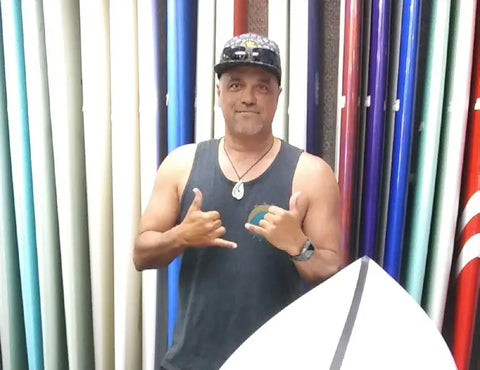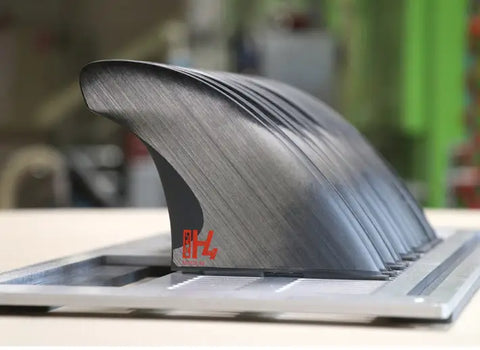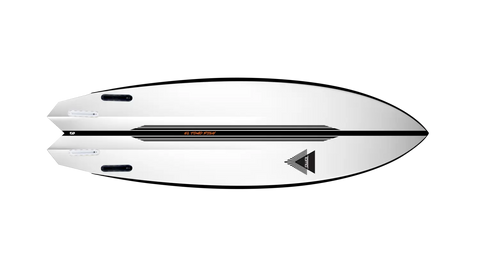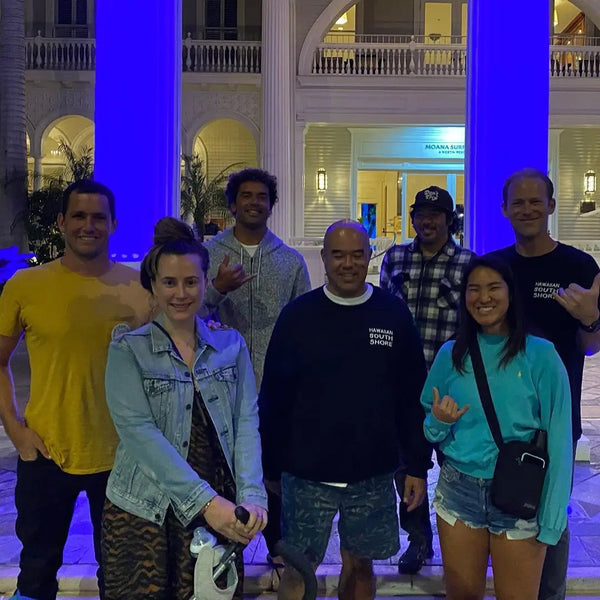Hawaiian South Shore April 2020 Newsletter
Share
NEWSLETTER APRIL 2020

A Busy and Exciting Month at Hawaiian South Shore
It has been a pretty exciting month here at Hawaiian South Shore, with a bunch of new arrivals, some celebrity visitors, and lots of stoked customers!
The month started off with a big shipment of new Firewire models, including the most anticipated El Tomo and Sci-Fi 2.0. The staff here was super excited to get our hands on these boards, and so were the store regulars, who quickly came in to check out the new models.
stoked and told me all about how rad our videos were, and how they helped shape his show. It’s pretty cool to meet and collaborate with someone who I have
become a fan of, and to find out that he is also a fan of us!
The Camper and The Slipper
Talking Boards With World Champion Longboarder Kai Sallas
Kai Sallas is a classic example of the Hawaiian longboarding aesthetic. Mentored by high-performance longboarding legends like Bonga Perkins and Russ K, Kai has proven himself on the world stage, taking 3rd and 2nd on the WSL Longboard Tour in 2017 and 2018 respectively, and also winning the ISA longboard world championships in 2018. But he is also a world-class logger, having honed his traditional skills at his home break of Queen’s Beach in Waikiki. Thus, it makes sense that his quiver would allow him to both shred and style his way to victory. Kai’s Camper model is built to be ridden on the nose. It has a wide template and a particularly wide nose to support tip time, with concave running through the entire bottom for direction control and speed. A single concave up front blends into a double concave through the rear of the board, and eventually a slight vee out the square tail for responsive turning from the rear of the board. But the camper isn’t just a dedicated log. It is also infinitely shreddable, from knee-high to triple overhead. In fact, Kai has ridden his at one-foot Queens and eight-foot Lanikea, proving just how versatile the board really is. The Camper comes in two sizes—a 9’1” x 23” x 2 5/8” and a 9’5” for bigger guys, or those who want to use it as a noserider. Kai tends to use the larger model as a single

fin when the waves are small and he wants to do traditional longboarding, whereas he likes the 9’1” as a 2+1 when the wave is pumping and he’s looking to shred. He normally uses a 7-inch middle fin with Accelerators for side fins.
Kai’s other model is the Slipper, a round pin longboard with a pulled in the nose that is built for going fast and jamming turns in the pocket. When it’s hollow and critical, or when he simply feels like taking his longboard vertical, Kai turns to his 9’0” x 22” x 2 5/8” Slipper to do the job. Next time you are out at Queens, keep an eye out for Kai and check out what he’s riding. After all, the best way to improve your surfing is to watch the best and see what they are riding!
April Member of the Month
Q & A with Keko Ledesma

When and why did you initially get into surfing?
I started bodyboarding at Waikiki wall probably when I was 11 or 12. I got my first
surfboard around 14 and was hooked from then on.
Did you have a time period you laid off from surfing?
There was a short period when a degenerative disc in my neck kept me out of the water and I returned mostly doing SUP. After of few years of the stand-up, my passion for shortboards returned and I was back into it.
What is your favorite thing about surfing?
The best part of surfing is being in nature and the stress relief it brings. Being a police officer for over 25 years surfing has kept me sane and physically fit
I also enjoy traveling I have been all through Central America, New Zealand japan Korea and Indonesia I have been living on the island of Kauai for 30 years. I moved there for the great surf and slower pace of life compared to Honolulu
Where is your favorite place to eat after surfing? What is your favorite item on the menu?
For after surf eats the açaí bowl at the Kalalea juice hut in Anahola is a great healthy alternative to a plate lunch Tell us about the board you recently purchased from us.
What model and size is it, and how do you like its performance?
I recently bought the sci-fi 2.0 602 with FCS 2 Mick Fanning fins I rode it at an undisclosed point break on Kauai. This break is known for its steep drops and power. I was a little worried about the sci-fi being able to handle it but I have to say that the board handled. I can tell this board will be my go-to the board especially in fun size waves this version feels more high performance and seems to have a bigger wave range compared to the original.
Do you have any additional comments?
Stoked with the service and knowledge the staff at Hawaiian south shore have
I would and have recommended your shop to my friends. Hawaiian south shore is da bomb!!!
Mahalo
Kekoa Ledesma
The H4 Fin Set
FCS Builds the Future
The surf media has written thousands of pages on the various attributes of surfboard design, but much less attention has been given to the part of the surfboard that actually steers it. Fins are an essential part of what makes surfboards work, but we have only recently begun to explore their potential, in terms of design, materials, and other features. For the most part, the fins on

today’s surfboards are pretty much exactly the same as the fins that were on boards 30 years ago—whether you are riding single fin longboards, retro twin fins, thrusters, or quads.
That’s all about to change with the release of FCS’s new H4 fin. This futuristic set of fins combines progressive, intuitive design with space-age materials and technology engineered by a Swiss company to produce the most efficient flex patterns in the fin market. The H4 blends a traditional fin outline with a hatchet-style tip on the side fins, creating extra drive and speed while simultaneously providing for release at the exact point that surfers want it. Meanwhile,
the unique, elliptical shape of the center fin lessens drag while providing control and predictability through turns.
The process used to create the fins is just as high-tech as the design. The fins are built with high-density, uni-directional carbon fiber, making them not only strong and light, but also fast. Meanwhile, the internal composite material on the trailing edge morphs under load, giving the fins drive and pep through turns and allowing them to be pushed hard without compromising control. Finally, a robotic construction process with camera-assisted quality control ensures a high level of accuracy and standardization so that you can be confident about your fins quality and reproducibility.
When all of these high-tech elements are combined, the result is a fin that is elegant in its simplicity. The H4 is custom-built to one specific purpose—to elevate modern surfing to the next level. Whether you are a professional surfer on the world tour or an everyman shredder out for his after-work session, I think we can all appreciate that.
Thunderbolt?
With Thunderbolt Technologies blanks, the internal flex control components can
be adjusted to provide the amount of flex needed in each part of the board. The
boards essentially get designed from the inside out based on what the surfers and designers want. The boards are 100% hand layups, which makes a high level of custom tuning possible, with each model and size built with its own unique flex control system. Once these hand-built blanks are finished, they can be laminated with a variety of materials ranging from XEON Fiberglass to carbon fiber.
With Carve’s high-performance boards, the most significant thing that everyone notices is the increase in energy projected by the board coming out of turns. The boards flex very well, so when to put hard on the rail, they draw a tighter arc, making for faster turns. Coming out of turns, the internal flex components generate a huge amount of energy when the board unflexes, projecting the board forward. This big uptick in responsiveness is what the riders love so much.
Traditional models also benefit from the advantages of flex and rebound but in more subtle ways. You can take Thunderbolt logs and put them on the rail when you want to, but the primary benefit CJ Nelson is looking for in his traditional models is enhancing flow and feel, and improving the responsiveness so that he can nimbly position the board exactly where he wants to be on a wave, rather than wrestling a more rigid, heavier log, as with traditional construction.
Thunderbolt blanks are also set up for the tail to twist as well as flex, which allows
the rider to control the board from the nose with a lot more dexterity than more rigid constructions.

Yu Sumitomo is the man who came up with the Thunderbolt technology, and his
commitment to quality and the constant pursuit of elevating performance is exceptional. His father, Tamotsu, started making surfboards in Japan over 40 years ago, and is one of the true innovators of the industry. Yu san learned a lot from his dad and has continued to advance the art of building surfboards to the highest levels. He is the reason that Mark Nelson got involved in the surfboard industry, and is as much a brother to Mark as he is a business partner. Between Mark, Yu, CJ, Harley, and Ben, Carve has grown into a thriving business and one that Hawaiian South Shore is proud to represent!
A Short, Pre-Surf Yoga Practice to Help You Shred Harder and Recover Faster
Surfing is an intensive, full-body activity that involves repetitive motion (paddling),
weird, posture-related tension (lower back tightness), frequent twisting (hips and
neck), and unbalanced weight distribution (back leg versus front). Taking that into
consideration, it’s no wonder that our bodies often feel tweaked after we surf.
One of the best things we can do to prepare our bodies to shred during each session and recover quickly after we paddle in is to integrate a short, effective yoga practice into our daily surf routine. This can be done in the morning when you wake up, shortly before paddling out, or after your session is complete—or all three, if you want! By focusing on flexibility, core strengthening, and balance, it’s possible to tune our bodies into the surfing activity, helping us rip into our 80s, and even longer!
Hawaiian South Shore’s resident yogi Kilty Inafuku suggests the following poses for surfers looking to limber up their bodies and improve their surf skills:

1) Thread the Needle: For this stretch, start on your hands and knees, with your
wrists under your shoulders and your knees under your hips. Your legs and feet should be hip-width apart, and your fingers should point toward the front of the mat. From this table-top position, thread your left arm behind your right hand and lower your left shoulder all the way down to the mat, with your left ear on the floor and gaze directed to the right. Keep your left palm facing up. Broaden the upper back and relax the lower back by gently pressing your left forearm into the ground. Hold the pose for a minute, then slowly come out of it and back into the
table-top shape. Repeat the stretch on the other side. This pose stretches the shoulders, back, and neck—all areas that are chronically tight on surfers. By performing this stretch before you surf, your body will be warmed up and limber for the session. And by performing it after you surf, you will release the tension
built up through repetitive motion and strain during your session.
2) Forward Fold With Interlaced Fingers Behind Your Back: This is a relatively simple pose and one that many people have probably done in some form. Standing with your feet at hip-width apart, interlace all ten fingers behind your back and slowly hinge forward from the hips. Folding forward with a small micro-bend in the knees will provide a stretch for the hamstrings and minimize potential strain on the low back. Then, allow the arms to elevate away from your back and up above your head to deepen the stretch, which benefits the front of the shoulders and upper pecs.
3) Happy Baby: This pose is great for stretching the hips and lower back and
putting you into a relaxed mood. Lying on your back, bring the legs up into the air and grasp the outer edges of the feet with each hand, keeping the low back on the floor as much as possible. Use your hands to pull gently downward on your feet, stretching both the inner thighs and outer hips.

We want to be social with you.
FB: @hawaiiansouthshore
IG: @hwnsouthshore





